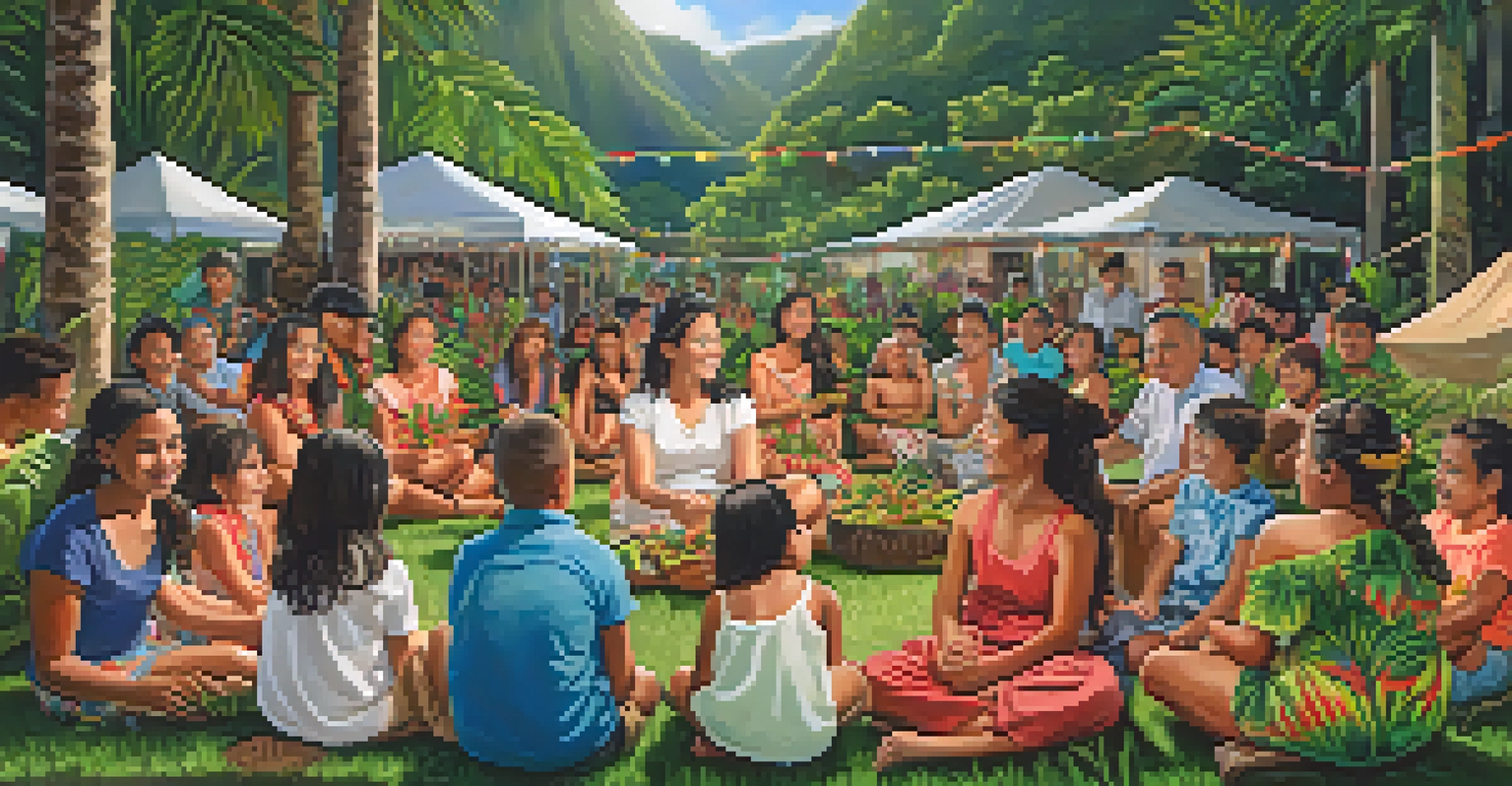The Importance of Hawaiian Language in Modern Education Systems

Cultural Significance of the Hawaiian Language Today
The Hawaiian language, or 'ʻŌlelo Hawaiʻi', is more than just a means of communication; it is a vital part of Hawaiian cultural identity. Recognizing and using this language helps preserve the rich traditions, stories, and values of the Hawaiian people. In modern education, incorporating 'ʻŌlelo Hawaiʻi' allows students to connect deeply with their heritage while fostering a sense of pride.
A language is something infinitely greater than grammar and philology. It is the poetic testament of the genius of a race and the culture of a nation.
When students engage with their native language, they gain insight into the values and history that shape their community. This connection can enhance their overall educational experience, making learning more relevant and meaningful. Moreover, it encourages the younger generation to embrace their roots, creating a bridge between past and present.
By valuing the Hawaiian language in schools, educators help cultivate a vibrant cultural identity among students. This not only enriches individual lives but also strengthens the broader community, ensuring the survival of unique cultural practices for future generations.
Hawaiian Language as a Tool for Enhancing Cognitive Skills
Learning a new language is often linked to improved cognitive abilities, and Hawaiian is no exception. Studies show that bilingual individuals tend to excel in problem-solving, critical thinking, and creativity. By integrating Hawaiian language instruction into modern education systems, students can develop a versatile skill set that benefits them academically and personally.

Furthermore, the process of learning Hawaiian encourages students to think differently, as the language's structure and vocabulary often reflect unique ways of viewing the world. This linguistic diversity can enhance students' adaptability and perspective-taking, crucial skills in today's interconnected society. It’s like adding another color to your palette; it allows for more creative expression.
Hawaiian Language Preserves Culture
Incorporating 'ʻŌlelo Hawaiʻi' in education helps maintain and celebrate Hawaiian cultural identity and traditions.
Ultimately, introducing students to 'ʻŌlelo Hawaiʻi' can lay a strong foundation for lifelong learning. As they grapple with new vocabulary and grammatical structures, they not only expand their linguistic repertoire but also boost their overall cognitive flexibility.
Integrating Hawaiian Language into Curriculum Design
To effectively promote the Hawaiian language, schools must integrate it into their curriculum thoughtfully. This means not just offering Hawaiian as an elective but embedding it across various subjects, such as history, science, and arts. By doing so, students can see the practical applications of their language skills in real-world contexts.
Language is the road map of a culture. It tells you where its people come from and where they are going.
For instance, a science class that uses Hawaiian terminology can enhance students' understanding of both the language and the scientific concepts being taught. It’s a win-win scenario that fosters a richer understanding of subjects while reinforcing language skills. This holistic approach encourages students to appreciate both their academic subjects and their cultural heritage.
Moreover, teachers can utilize local stories and legends in their lessons, creating a dynamic learning environment that resonates with students. This not only helps in language retention but also makes learning more engaging and culturally relevant.
The Role of Technology in Promoting Hawaiian Language
In today’s digital age, technology plays a crucial role in language preservation and education. Various online platforms and applications have emerged that promote the learning of Hawaiian, making it accessible to students and community members alike. These tools not only provide interactive learning experiences but also foster a sense of community among learners.
For example, mobile apps that teach Hawaiian vocabulary through games and quizzes can make the language fun and engaging for younger audiences. This approach taps into the interests of today's tech-savvy students, encouraging them to embrace their culture in a format they enjoy. Think of it as finding a new way to connect with your favorite story—like reading a book or watching a movie.
Language Learning Enhances Skills
Studying Hawaiian can boost cognitive abilities, fostering critical thinking and creativity among students.
Additionally, social media platforms can serve as spaces for practice and community engagement, where learners can share their experiences and progress. This not only enhances language use but also builds a supportive network of learners, creating a vibrant community dedicated to preserving and promoting 'ʻŌlelo Hawaiʻi'.
Challenges Facing Hawaiian Language Education
Despite its importance, the Hawaiian language faces several challenges in modern education systems. One major hurdle is the lack of qualified teachers fluent in 'ʻŌlelo Hawaiʻi', which can limit the availability of Hawaiian language courses. This shortage can hinder students' access to quality education in their native language, creating a gap in cultural and linguistic knowledge.
Another issue is the perception that Hawaiian is less valuable than more widely spoken languages like English or Spanish. This viewpoint can discourage students from pursuing their language studies, leading to a decline in fluency among younger generations. It’s akin to being told that your favorite hobby isn't worth investing time in; it can diminish enthusiasm and participation.
Addressing these challenges requires concerted efforts from educators, policymakers, and the community. By advocating for more resources, training programs, and awareness campaigns, we can help pave the way for a stronger presence of Hawaiian in education, ensuring that it thrives alongside other languages.
Community Involvement in Hawaiian Language Education
Community involvement is essential for the successful integration of Hawaiian language in education. Parents, cultural practitioners, and local organizations can play a significant role in supporting schools and students. By collaborating with educators, they can provide resources, share knowledge, and create meaningful learning opportunities that enrich students’ experiences.
For instance, local cultural events can serve as platforms for students to practice their language skills in real-life situations. Engaging with community members during these events fosters a sense of belonging and reinforces the importance of 'ʻŌlelo Hawaiʻi' in daily life. It’s like having a family reunion where everyone gathers to share stories and traditions—each interaction strengthens the bond.
Community Support is Crucial
Active involvement from families and local organizations is essential for the successful integration of Hawaiian language education.
Moreover, involving the community in educational initiatives can lead to increased support for Hawaiian language programs. When families and local organizations see the value in these efforts, they are more likely to advocate for their continuation and growth, creating a sustainable ecosystem for language learning.
The Future of Hawaiian Language in Education
Looking ahead, the future of Hawaiian language in education is promising, but it requires ongoing commitment and innovation. As more schools recognize the value of 'ʻŌlelo Hawaiʻi', we can expect to see an increase in programs and resources dedicated to its teaching. This momentum will be essential in reversing the decline of fluent speakers and ensuring the language's survival.
Additionally, incorporating modern teaching methods, such as blended learning and cultural immersion, can enhance students' engagement. By embracing innovative approaches, educators can create dynamic learning environments that resonate with students. It’s similar to using a favorite recipe but adding your twist; it keeps the essence while making it your own.

Ultimately, fostering a love for the Hawaiian language among students will require collaboration among educators, families, and the wider community. By working together, we can ensure that 'ʻŌlelo Hawaiʻi' not only survives but thrives in modern educational settings, enriching the lives of future generations.